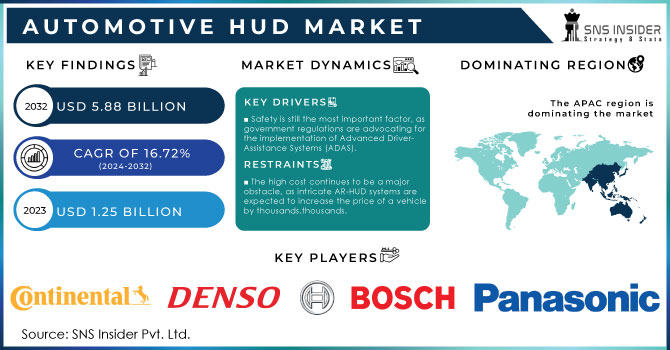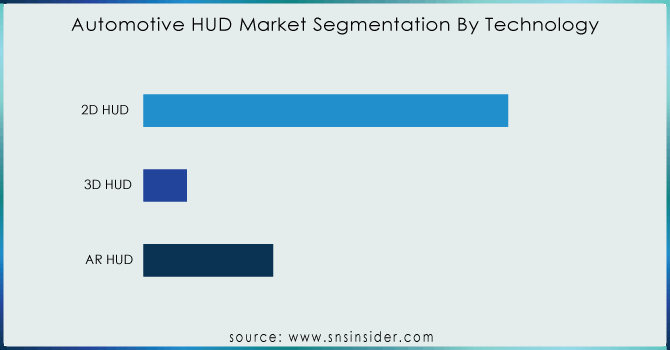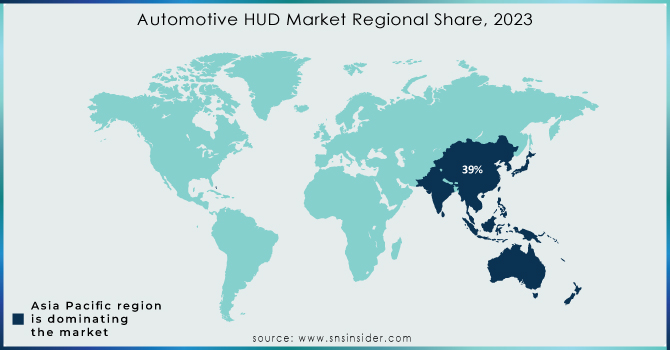Automotive HUD Market Size & Overview:

Get More Information on Automotive HUD Market - Request Sample Report
The Automotive HUD Market size was valued at USD 1.25 billion in 2023 and is expected to reach USD 5.88 billion by 2032, the estimated CAGR for the forecast period of 2024-2032 is 16.72%.
The Automotive HUD Market is experiencing a rapid growth in terms of overall demand and acceptance. According to the National Highway Traffic Safety Administration (NHTSA), 94% of crashes are caused by driver error. HUDs improve on this by keeping important information such as speed, navigation and blind spot warnings right in the driver's line of sight, reducing the need to take their eyes off the road. In addition, 72% of US consumers consider advanced driver assistance systems (ADAS) a top priority when purchasing a car. AR HUDs, the next frontier in this technology, seamlessly combine real elements with projected information. These features include tech demographics, with millennials representing more than 60% of people interested in AR HUDs.
One of the most important trends is the growth of HUDs with Augmented Reality (AR), which is projected to grow by a significant rate of 25% by 2031. Another trend is the growing demand for elegant and discreet HUD designs. More than 60% of consumers now prioritize aesthetics and prefer HUDs that integrate seamlessly with modern cars. This change reflects the desire for technology that completes the driving experience, not diminishes it. Finally, HUD innovation is driven by the growth of electric vehicles (EV). Almost half of the electric vehicles manufacturers are actively developing HUD systems specially adapted to the needs of electric cars. These HUDs can display battery range, charging stations and energy efficiency metrics, providing an evolving landscape of environmentally conscious driving.
How is the demand curve shifting amidst high external volatility?
Despite the possibility of a decline in overall auto sales owing to economic uncertainties, there are several reasons to believe that demand for automobiles acquired through HUD will rise. First, in-car technology is a top priority for Millennials and Gen Z, and HUDs immediately address this demand by making driving safer and more comfortable. Manufacturers are being forced to incorporate technologies that raise driver awareness due to the increased focus on fuel efficiency; HUDs, in particular, notably speed up response times and reduce fuel use. A perspective shift in the market is imminent with the introduction of augmented reality (AR) head-up displays. Just picture crucial navigational data or safety alerts displayed directly above the driver's line of sight. Even with the unpredictability of the external market, this fascinating technology is likely to considerably increase demand.
Automotive HUD Market Dynamics
Drivers:
-
Safety is still the most important factor, as government regulations are advocating for the implementation of Advanced Driver-Assistance Systems (ADAS).
-
Government efforts to encourage connected car technologies such as intelligent transport systems (ITS) offer a chance for HUDs.
-
The luxury car category, accounting for 20% of worldwide car sales, plays a crucial role.
The rising luxury cars sales globally is the driving force behind the HUD market. This is because luxury car manufacturers are at the forefront of introducing new technologies and positioning HUDs as premium features that enhance the driving experience. This focus on innovation will spread to the wider market as HUD technology matures and becomes more affordable. Moreover, different sub-segments in the Automotive HUD market provide to different preferences. Windshield HUDs, which project information directly onto the windshield, have the largest share at 60%.
Restrains:
-
The high cost continues to be a major obstacle, as intricate AR-HUD systems are expected to increase the price of a vehicle by thousands.
-
Automakers face packaging challenges when integrating large HUD hardware into sleek, modern dashboards.
-
Maintaining clear and accurate information display is challenging due to various windshield angles and lighting conditions.
Future threats which need to be monitored by the players operating in Automotive HUD Market.
The complexity of the technology is a significant challenge due to the integration of various components such as micro displays, projectors, and combiners from different suppliers. A 2023 study shows a 42% vulnerability in meeting on-time deliveries. Moreover, the quick progress in AR HUDs also brings about more challenges.
Manufacturers face a limited talent pool due to the need for knowledge in micro-optics and software development to work on advanced displays. A recently conducted survey in Q1 2024 indicates that a skill gap may hamper the widespread adoption of AR HUD by 38% during the forecasted period. At last, the sector contends with geopolitical tensions and trade conflicts, which have the potential to interrupt the supply of essential raw materials and finished parts.
Automotive HUD Market Segmentation:
By Technology:
2D HUDs dominate the market with approximately 70% market share by projecting information onto the windshield. Manufacturers often choose them due to their simplicity and affordability. 3D HUDs, accounting for about 5% of the market share, provide a more visually engaging experience through a layered information display that includes depth perception. As costs for this technology decrease and consumer desire for a high-quality in-car experience increases, it is projected to become more popular. AR HUDs, despite being at the forefront, still make up a small portion of the market at roughly 25%.

Get Customized Report as per your Business Requirement - Request For Customized Report
By Vehicle Type:
Passenger cars are expected to maintain the majority market share at approximately 70% and are taking the lead. Several factors are responsible for this dominance. Passenger cars have a greater production volume than commercial vehicles. Secondly, passenger car consumers typically show a greater interest in advanced technological features and a focus on improving driving experiences. This results in a greater readiness to shell out money for features such as HUDs. On the other hand, the commercial vehicle sector, including both Light Commercial Vehicles (LCVs) and Heavy Commercial Vehicles (HCVs), makes up the remaining 30%.
By Propulsion Type:
While Internal Combustion Engine (ICE) vehicles currently hold the larger market share holding 65%, Electric Vehicles (EVs) are guaranteed for significant growth. This can be attributed to several factors. Firstly, premium features like HUDs are often bundled with advanced driver-assistance systems (ADAS) that are becoming increasingly common in EVs due to a focus on safety and automation. Secondly, the focus on creating a more futuristic driving experience aligns well with the innovative image of EVs. As EV adoption accelerates, SNS Insider analysts predict the EV segment to capture a larger share of the HUD market, potentially reaching 40% by 2032.
Automotive HUD Market Regional Analysis:
The Automotive HUD market in APAC has the highest market share at 39%. Several factors are responsible for this dominance. To begin with, a thriving car industry, especially in Japan, drives a high need for state-of-the-art technology in cars. Also, an expanding middle class with increasing disposable income drives the demand for high-end features such as HUDs. Demographics also have an impact, as a youthful, technology obsessed population eagerly adopts new in-vehicle experiences. This younger age group can be found mostly in China, India, and South Korea, where they are actively working on advancing autonomous driving technologies. The emphasis on ADAS enhances the market growth by synergizing with HUDs. The supply chain in APAC is strong, as leading OEMs such as Toyota, Honda, and Hyundai collaborate with established HUD manufacturers such as Continental and Denso. In addition, there are also new local players in China that provide affordable HUD solutions, making them appealing to a wider variety of car markets.
APAC Competitive Analysis:
Well-known companies like Nippon Seiki in Japan and Continental in Germany operate alongside strong regional companies like Foryou in China. These large companies control the OEM market by providing HUDs directly to automotive manufacturers. With their solid technical skills and existing partnerships in the automotive industry, they collectively control more than 60% of the market share. Nevertheless, the area experiences a lively secondary market segment too. In this region, companies such as Waylabs in China and Hudway in Taiwan are successful, providing creative and budget-friendly HUD systems for cars already on the road. This part addresses the increasing need for cost-effective options, specifically in emerging markets in APAC, and represents about 40% of the market.

Automotive HUD Market Key Players:
The major Automotive HUD Market key players are as follows:
-
Continental AG (Combiner HUD, Windshield HUD)
-
Denso Corporation (AR HUD, Standard HUD)
-
Nippon Seiki Co., Ltd. (LCD HUD, OLED HUD)
-
Bosch (3D HUD, AR HUD)
-
Panasonic Corporation (Transparent Display HUD, Interactive HUD)
-
Valeo (Laser-based HUD, Digital HUD)
-
Harman International (Full-Windshield HUD, Augmented Reality HUD)
-
Garmin Ltd. (Portable HUD, Navigation HUD)
-
Visteon Corporation (AR Combiner HUD, Dual-Mode HUD)
-
Yazaki Corporation (Compact HUD, Free-form Optics HUD)
-
Hudway LLC (Hudway Cast, Hudway Glass)
-
WayRay (Holographic AR HUD, 3D Navigation HUD)
-
Pioneer Corporation (Full Color HUD, NaviGate HUD)
-
Harman (Digital Cockpit HUD, Interactive HUD)
-
JVCKENWOOD Corporation (Smart HUD, Heads-Up Navigation Display)
-
LG Electronics (Transparent OLED HUD, Dual Display HUD)
-
Koito Manufacturing Co., Ltd. (Combiner HUD, Laser HUD)
-
Hyundai Mobis (Curved HUD, AR Navigation HUD)
-
Texas Instruments (DLP HUD, High-Resolution HUD)
-
Robertshaw Controls Company (Micro Display HUD, Projection HUD)
Automotive HUD Market Recent Developments:
-
Panasonic Holdings Corporation and Mazda Motor Corporation partnered to develop a full-display meter system for the Mazda CX-70 model. This system incorporates a large display that functions similarly to a HUD, projecting vehicle information directly in the driver's line of sight.
-
Nippon Seiki Co., Ltd., a supplier of automotive displays and components, partnered with FPT Software to develop next-generation HUD platforms and applications for cars and motorcycles.
| Report Attributes | Details |
|---|---|
| Market Size in 2023 | US$ 1.25 Billion |
| Market Size by 2032 | US$ 5.88 Billion |
| CAGR | CAGR of 16.72% From 2024 to 2032 |
| Base Year | 2023 |
| Forecast Period | 2024-2032 |
| Historical Data | 2020-2022 |
| Report Scope & Coverage | Market Size, Segments Analysis, Competitive Landscape, Regional Analysis, DROC & SWOT Analysis, Forecast Outlook |
| Key Segments | • By Technology • By HUD Type • By Vehicle Class • By Vehicle Type • By Propulsion Type • By Level Of Autonomy • By Offering |
| Regional Analysis/Coverage | North America (US, Canada, Mexico), Europe (Eastern Europe [Poland, Romania, Hungary, Turkey, Rest of Eastern Europe] Western Europe] Germany, France, UK, Italy, Spain, Netherlands, Switzerland, Austria, Rest of Western Europe]), Asia Pacific (China, India, Japan, South Korea, Vietnam, Singapore, Australia, Rest of Asia Pacific), Middle East & Africa (Middle East [UAE, Egypt, Saudi Arabia, Qatar, Rest of Middle East], Africa [Nigeria, South Africa, Rest of Africa], Latin America (Brazil, Argentina, Colombia, Rest of Latin America) |
| Company Profiles | Continental AG, Denso Corporation, Nippon Seiki Co., Ltd., Bosch, Panasonic Corporation, Valeo, Harman International, Garmin Ltd., Visteon Corporation, Yazaki Corporation, Hudway LLC, WayRay and others. |
| Key Drivers | • Safety is still the most important factor, as government regulations are advocating for the implementation of Advanced Driver-Assistance Systems (ADAS). • Government efforts to encourage connected car technologies such as intelligent transport systems (ITS) offer a chance for HUDs. • The luxury car category, accounting for 20% of worldwide car sales, plays a crucial role. |
| Restraints | • The high cost continues to be a major obstacle, as intricate AR-HUD systems are expected to increase the price of a vehicle by thousands. • Automakers face packaging challenges when integrating large HUD hardware into sleek, modern dashboards. • Maintaining clear and accurate information display is challenging due to various windshield angles and lighting conditions. |

